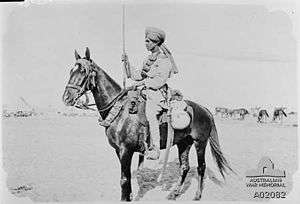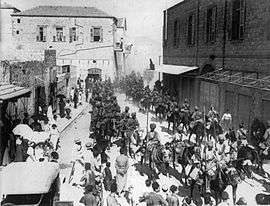Battle of Haifa (1918)
| ||||||||||||||||||||||||||||||||
The Battle of Haifa was fought on 23 September 1918 towards the end of the Battle of Sharon which together with the Battle of Nablus formed the set piece Battle of Megiddo fought between 19 and 25 September during the last months of the Sinai and Palestine Campaign of the First World War. During the Battle of Haifa, the Indian 15th (Imperial Service) Cavalry Brigade, 5th Cavalry Division and part of the Desert Mounted Corps attacked rearguard forces of the Ottoman Empire that resulted in the capture of the towns of Haifa and Acre. This attack took place at the north western edge of the Esdraelon Plain (also known as the Jezreel Valley and the plain of Armageddon) 40–50 miles (64–80 km) behind the front line in the Judean Hills after the Desert Mounted Corps had occupied the plain, during the cavalry phase of the Battle of Sharon.
The Battle of Megiddo had begun with an attack by British Empire infantry along an almost continuous line from the Mediterranean Sea across the Plain of Sharon into the foothills of the Judean Hills. They attacked the Ottoman front line and captured the headquarters of the Ottoman Eighth Army at Tulkarm, the trenches at Tabsor and pivoted at Arara. The Eighth Army was outflanked on the coast and British Empire cavalry moved north through the gap created. The Desert Mounted Corps almost encircled the infantry in the Judean Hills capturing their main lines of supply, communications and retreat. By 25 September, one Ottoman army had been destroyed, and what remained of two others, were in retreat northwards to Damascus.
The 5th Cavalry Division was assigned the task of capturing Haifa and Acre after several earlier attempts were stopped by strong rearguard positions. A squadron from the Mysore Lancers, and a squadron from the Sherwood Rangers Yeomanry, 15th (Imperial Service) Cavalry Brigade formed the initial attack on an Austrian artillery battery before moving forward with the Jodhpur Lancers and a light car patrol, to attack the main German rearguard position and capture the town.
Background

The 5th Cavalry Division were formed with three brigades, two of them composed of one British yeomanry regiment, and two British Indian Army cavalry regiments; one of which was usually lancers. Part of the Desert Mounted Corps, it was supported by machine guns, artillery, and light armoured car units.[2] The division's third brigade was the 15th (Imperial Service) Cavalry Brigade, normally comprising three cavalry regiments from the Indian Princely States of Jodhpur, Mysore and Hyderabad. However the Hyderabad Lancers had been detached to escort prisoners and had been replaced by the Sherwood Rangers Yeomanry from the divisions 14th Cavalry Brigade.[3][4]
Following the successful advance and virtual encirclement of the Ottoman Seventh and Eighth Armies in the Judean Hills with the captures of Afulah and Nazareth the Yildirim Army Group general headquarters was out of communication with its three armies.[5][6][7] All direct routes northwards were controlled by the Desert Mounted Corps and so the retreating Seventh Army and what remained of the Eighth Army, was forced to withdraw along minor roads or tracks, eastwards across the Jordan River, towards the Hedjaz railway.[8][9] The capture of Haifa was essential to any further advances by the Egyptian Expeditionary Force, the roads leading to the port were little more than tracks and as its capture was urgently required for landing supplies.[10][11]
Prelude

Shortly after midnight on 21/22 September, the 18th King George's Own Lancers, part of the 13th Cavalry Brigade, were advancing along the Acre road to the west of the town, when they were attacked by an Ottoman battalion from Haifa. They routed the battalion, after a short fight inflicting 30 casualties and capturing more than 200 prisoners.[12]
On 22 September an aerial reconnaissance reported that Haifa had been evacuated by the Ottoman army. This was found to be inaccurate when the Haifa Annexation Expedition was stopped by accurate Ottoman artillery and machine gun fire.[13] A reconnaissance by armoured cars of the Light Car Patrol encountered a redoubt, 200 yards (180 m) from the road to Haifa. This strong rearguard with machine guns was supported by effectively positioned artillery deployed on the lower slopes of Mount Carmel. The redoubt was fired on by the cars' machine guns and quickly surrendered, while 2 miles (3.2 km) further on, they encountered an Austrian battery of light field guns, supported by German machine gunners which stopped the reconnaissance force.[14][15] They controlled the approach road from the east, which ran between the mountain and the Nahr el Muqatta. This strong position, could not be outflanked because the Nahr el Mugatta river was edged on both sides by marshes, making it virtually impossible to cross.[15] The 5th Cavalry Division was ordered to capture Haifa and Acre 12 miles (19 km) north west the following day.[16]
Battle

On 23 September 1918 the 15th (Imperial Service) Cavalry Brigade was ordered to capture Haifa. The area between the river Nahr el Mugatta also known as the river Kishon and the slopes of Mount Carmel was well defended by Ottoman gun emplacements and artillery. The brigade's Jodhpur Lancers were tasked to capture this position, while the Mysore Lancers moved around to attack the town from the east and north.[3]
A squadron of the Mysore Lancers and a squadron of the Sherwood Rangers Yeomanry, supported by B Battery, Honourable Artillery Company, attacked the Austrian battery of light field guns on the slopes of Mount Carmel at 14:00. The squadron of Mysore Lancers had moved into position by climbing up a steep track to capture and silence the guns, while the Jodhpur Lancers and the remainder of the Mysore Lancers launched the main mounted attack on the rearguard of German machine gunners, which blocked the road 2 miles (3.2 km) on from the redoubt captured the day before by the Light Car Patrol.[14][17]
The Jodhpur Lancers charged the Ottoman position, crossing the Acre railway line, but came under machine gun and artillery fire. The charge was further obstructed by quicksand on the river banks, so they manoeuvred to the left onto the lower slopes of Mount Carmel. The regiment secured the position capturing 30 prisoners, two machine guns, two camel guns and opening up an access route into Haifa. The Jodhpur Lancers continued their charge into the town surprising the defenders. Those Mysore Lancers who had been giving fire support to the attacking regiment, mounted and followed them into the town. Together the two regiments captured 1,350 German and Ottoman prisoners, including two German officers, 35 Ottoman officers, 17 artillery guns including four 4.2 guns, eight 77mm guns and four camel guns as well as a 6-inch naval gun, and 11 machine guns. Their own casualties amounted to eight dead and 34 wounded. 60 horses were killed and another 83 injured.[3][17][18]
We tried to cover the Turks’ retreat, but we expected them to do something, if only keep their heads. At last we decided they were not worth fighting for.— A captured German officer[19]
Aftermath
Soon afterwards the 13th Cavalry Brigade captured Acre, to the north, together with its garrison of 150 men and two artillery guns.[11] On 26 September the 300 strong remnant of the Haifa garrison arrived at Beirut and were ordered inland to Riyak, to the north of Damascus.[20]
Allenby reported on 25 September to the War Office regarding the proposed advance to Aleppo and the general situation of the battle:
I have your HW wire and that from Troopers proposing a Cavalry raid to Aleppo. I don't think Aleppo possible; but am sending 3 Divisions of Cavalry, as soon as I can, to Damascus. Chaytor's Division of Anzac Light Horse is about Amman now, and will deal with enemy coming from the South. Prisoners number well over 40,000 and are still coming in. I have Australian mounted troops at the S. end of Lake Tiberias, and they are pushing to Tiberias. If I get Damascus, Beirut falls to us certainly; and I hope to push troops, Northwards, thither, by the coast–road from Haifa, feeding from the sea, stage by stage.— Allenby to Wilson CIGS War Office 25 September 1918[21]
By 29 September, the 7th (Meerut) Division was concentrated at Haifa with the XXI Corps Cavalry Regiment at Acre in preparation for their march to Beirut.[22]
The Jodhpur and Mysore Lancers are now represented by 61st Cavalry Regiment, in the Indian Army and still commemorate the battle every year on the 23 September as Haifa Day.
-

Memorial to the Imperial Service Cavalry Brigade, New Delhi
-

Mysore Lancers Memorial at Bangalore for lives lost in Egypt & Palestine
-
%2C_Bangalore.jpg)
Mysore Lancers Memorial at Bangalore for lives lost in Egypt & Palestine
Citations
- 1 2 H.M.S.O. 1920, p.27
- ↑ DiMarco 2008 p. 328
- 1 2 3 "Battle of Haifa: 23 Sep 1918". NDTV. Retrieved 6 February 2012.
- ↑ Falls 1930 Vol. 2 p. 667
- ↑ Maunsell 1926 p.213
- ↑ Carver 2003 p. 232
- ↑ Blenkinsop 1925 p. 236
- ↑ Bruce 2002 p. 231
- ↑ Maunsell 1926 p. 221
- ↑ Paget 1994 Vol. 2 p. 295
- 1 2 The London Gazette: (Supplement) no. 31087. p. 15188. 27 December 1918.
- ↑ Wavell 1968 pp. 214–5
- ↑ Hill 1978 pp. 171–2
- 1 2 Gullett 1919 pp. 38–9
- 1 2 Bruce 2002 p. 234
- ↑ DiMarco 2008 p. 332
- 1 2 Bruce 2002 p. 235
- ↑ Massey 1920 pp. 190–4
- ↑ in Gullett 1919 pp. 38–9
- ↑ Falls 1930 Vol. 2 p. 594
- ↑ Hughes 2004 p. 183
- ↑ Falls 1930 Vol. 2 pp. 563, 597
References
- Blenkinsop, Layton John; Rainey, John Wakefield, eds. (1925). Veterinary Services. Official History of the Great War Based on Official Documents by Direction of the Historical Section of the Committee of Imperial Defence. London: HMSO. OCLC 460717714.
- Bruce, Anthony (2002). The Last Crusade: The Palestine Campaign in the First World War. London: John Murray. ISBN 978-0-7195-5432-2.
- Carver, Michael, Field Marshal Lord (2003). The National Army Museum Book of The Turkish Front 1914–1918: The Campaigns at Gallipoli, in Mesopotamia and in Palestine. London: Pan Macmillan. ISBN 978-0-283-07347-2.
- DiMarco, Louis A. (2008). War Horse: A History of the Military Horse and Rider. Yardley, Pennsylvania: Westholme Publishing. OCLC 226378925.
- Falls, Cyril (1930). Military Operations Egypt and Palestine: From June 1917 to the End of the War. Official History of the Great War Based on Official Documents by Direction of the Historical Section of the Committee of Imperial Defence. II Part 2. A. F. Becke (maps). London: HMSO. OCLC 256950972.
- Gullett, Henry S.; Barnet, Charles; Baker (Art Editor), David, eds. (1919). Australia in Palestine. Sydney: Angus & Robertson. OCLC 224023558.
- Hill, Alec Jeffrey (1978). Chauvel of the Light Horse: A Biography of General Sir Harry Chauvel, GCMG, KCB. Melbourne: Melbourne University Press. OCLC 5003626.
- History of the 15th (Imperial Service) Cavalry Brigade during the Great War 1914–1918. HMSO. 1920.
- Massey, William Thomas (1920). Allenby's Final Triumph. London: Constable & Co. OCLC 345306.
- Maunsell, E. B. (1926). Prince of Wales' Own, the Seinde Horse, 1839–1922. Regimental Committee. OCLC 221077029.
- Paget, G. C. H. V Marquess of Anglesey (1994). Egypt, Palestine and Syria 1914 to 1919. A History of the British Cavalry 1816–1919. V. London: Leo Cooper. ISBN 978-0-85052-395-9.
- Wavell, Field Marshal Earl (1968) [1933]. "The Palestine Campaigns". In Sheppard, Eric William. A Short History of the British Army (4th ed.). London: Constable. OCLC 35621223.
External links
- Piece of New Delhi in Haifa – Israel Defense Forces
Coordinates: 32°49′0″N 34°59′0″E / 32.81667°N 34.98333°E
